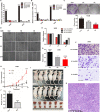Exosome-transmitted linc00852 associated with receptor tyrosine kinase AXL dysregulates the proliferation and invasion of osteosarcoma
- PMID: 32673448
- PMCID: PMC7476833
- DOI: 10.1002/cam4.3303
Exosome-transmitted linc00852 associated with receptor tyrosine kinase AXL dysregulates the proliferation and invasion of osteosarcoma
Abstract
Background: Receptor tyrosine kinase AXL has been found to be highly expressed in osteosarcoma and positively associated with poor prognosis. There are tumor groups with high or low AXL expression, which had different capabilities of invading vessels and forming distal metastases. Exosome-transmitted lncRNA may be transferred intercellularly to promote tumor cells' proliferation and invasion.
Methods: Exosomes were detected by electron microscopy, particle size analysis, and western blotting. High-throughput sequencing helped to find the highest differentially expressed lncRNA in AXL-associated exosomes. Clone formation, wound healing, transwell assay, and xenograft model in nude mice were performed to evaluate cells' proliferation, migration, and invasion in vitro and in vivo. Lentiviral transfection was used to up- or down-regulate the lncRNA levels in cell lines. Luciferase reporter assay and RNA FISH etchelped to indicate the molecular mechanisms. The results in the cell lines were proved in the osteosarcoma tissues with clinical analysis.
Results: The exosomes derived from donor cells with high AXL expression could promote the proliferation and invasion and upregulate AXL expression of the receiver cells with low AXL. Linc00852 was the highest differentially expressed lncRNA in AXL-associated exosomes and was also regulated by AXL expression. Although the mechanisms of linc00852 in nucleus were unrevealed, it could upregulate AXL expression partly by competitively binding to miR-7-5p. The AXL-exosome-linc00852-AXL positive feedback loop might exist between the donor cells and the receiver cells. Clinically, linc00852 was significantly highly expressed in osteosarcoma tissues and positively associated with tumor volumes and metastases, which was also obviously related with AXL mRNA expression.
Conclusion: AXL-associated exosomal linc00852 up-regulated the proliferation, migration, and invasion of osteosarcoma cells, which would be considered as a new tumor biomarker and a special therapeutic target for osteosarcoma.
Keywords: AXL; exosome; invasion; linc00852; osteosarcoma.
© 2020 The Authors. Cancer Medicine published by John Wiley & Sons Ltd.
Conflict of interest statement
It has been submitted with the full knowledge and approval of the First Affiliated Hospital, Sun Yat‐sen University. All authors have significantly contributed and are in agreement with the content of the final manuscript. The authors declare that there are no conflict of interest in connection with the work submitted.
Figures






Similar articles
-
lncRNA DANCR promotes tumor progression and cancer stemness features in osteosarcoma by upregulating AXL via miR-33a-5p inhibition.Cancer Lett. 2017 Oct 1;405:46-55. doi: 10.1016/j.canlet.2017.06.009. Epub 2017 Jun 19. Cancer Lett. 2017. PMID: 28642170
-
LncRNA MEG3 negatively modified osteosarcoma development through regulation of miR-361-5p and FoxM1.J Cell Physiol. 2019 Aug;234(8):13464-13480. doi: 10.1002/jcp.28026. Epub 2019 Jan 9. J Cell Physiol. 2019. PMID: 30624782
-
LncRNA MALAT1 Promotes Cancer Metastasis in Osteosarcoma via Activation of the PI3K-Akt Signaling Pathway.Cell Physiol Biochem. 2018;51(3):1313-1326. doi: 10.1159/000495550. Epub 2018 Nov 27. Cell Physiol Biochem. 2018. Retraction in: Cell Physiol Biochem. 2024 Jan 31;58(1):106. doi: 10.33594/000000687. PMID: 30481748 Retracted.
-
Receptor tyrosine kinases in osteosarcoma: not just the usual suspects.Adv Exp Med Biol. 2014;804:47-66. doi: 10.1007/978-3-319-04843-7_3. Adv Exp Med Biol. 2014. PMID: 24924168 Review.
-
The promising roles of exosomal microRNAs in osteosarcoma: A new insight into the clinical therapy.Biomed Pharmacother. 2023 Jul;163:114771. doi: 10.1016/j.biopha.2023.114771. Epub 2023 Apr 27. Biomed Pharmacother. 2023. PMID: 37119740 Review.
Cited by
-
Delineating the role of extracellular vesicles in cancer metastasis: A comprehensive review.Front Immunol. 2022 Aug 19;13:966661. doi: 10.3389/fimmu.2022.966661. eCollection 2022. Front Immunol. 2022. PMID: 36059497 Free PMC article. Review.
-
MiR-7 in Cancer Development.Biomedicines. 2021 Mar 23;9(3):325. doi: 10.3390/biomedicines9030325. Biomedicines. 2021. PMID: 33806891 Free PMC article. Review.
-
Extracellular vesicles as a new frontier of diagnostic biomarkers in osteosarcoma diseases: a bibliometric and visualized study.Front Oncol. 2024 Mar 4;14:1359807. doi: 10.3389/fonc.2024.1359807. eCollection 2024. Front Oncol. 2024. PMID: 38500663 Free PMC article.
-
Extracellular vesicles in tumorigenesis, metastasis, chemotherapy resistance and intercellular communication in osteosarcoma.Bioengineered. 2023 Dec;14(1):113-128. doi: 10.1080/21655979.2022.2161711. Bioengineered. 2023. PMID: 37377390 Free PMC article. Review.
-
Highly enriched exosomal lncRNA OIP5-AS1 regulates osteosarcoma tumor angiogenesis and autophagy through miR-153 and ATG5.Am J Transl Res. 2021 May 15;13(5):4211-4223. eCollection 2021. Am J Transl Res. 2021. PMID: 34150009 Free PMC article.
References
-
- Jiang N, Wang X, Xie X, et al. lncRNA DANCR promotes tumor progression and cancer stemness features in osteosarcoma by upregulating AXL via miR‐33a‐5p inhibition. Cancer Lett. 2017;405:46‐55. - PubMed
-
- Antony J, Huang RY. AXL‐driven EMT state as a targetable conduit in cancer. Cancer Res. 2017;77(14):3725‐3732. - PubMed
Publication types
MeSH terms
Substances
LinkOut - more resources
Full Text Sources
Medical
Research Materials
Miscellaneous

